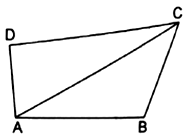In the adjoining figure, ![]() is a quadrilateral and
is a quadrilateral and ![]() is one of its diagonals. Prove that:
is one of its diagonals. Prove that:
(i) ![]()
(ii) ![]()
(iii) ![]()

Given: In ABCD, AC is one of diagonals.
To prove:
(i) ![]()
(ii) ![]()
(iii) ![]()
Proof:
(i) We know that the sum of any two sides of a triangle is greater than the third side.
In ∆ABC,
AB + BC > AC ...(1)
In ∆ACD,
CD + DA > AC ...(2)
Adding (1) and (2), we get,
AB + BC + CD + DA > 2AC
(ii) In ∆ABC, we have,
AB + BC > AC ...(1)
We also know that the length of each side of a triangle is greater than the positive difference of the length of the other two sides.
In ∆ACD, we have:
AC > DA – CD ...(2)
From (1) and (2), we have,
AB + BC > DA − CD
∴ AB + BC + CD > DA
(ii) In ∆ABC,
AB + BC > AC …(1)
In ∆ACD,
CD + DA > AC …(2)
In ∆ BCD,
BC + CD > BD …(3)
In ∆ ABD,
DA + AB > BD …(4)
Adding 1, 2, 3 and 4, we get,
2(AB + BC + CD + DA) > 2(AC + BD)
∴ AB + BC + CD + DA > AC + BD